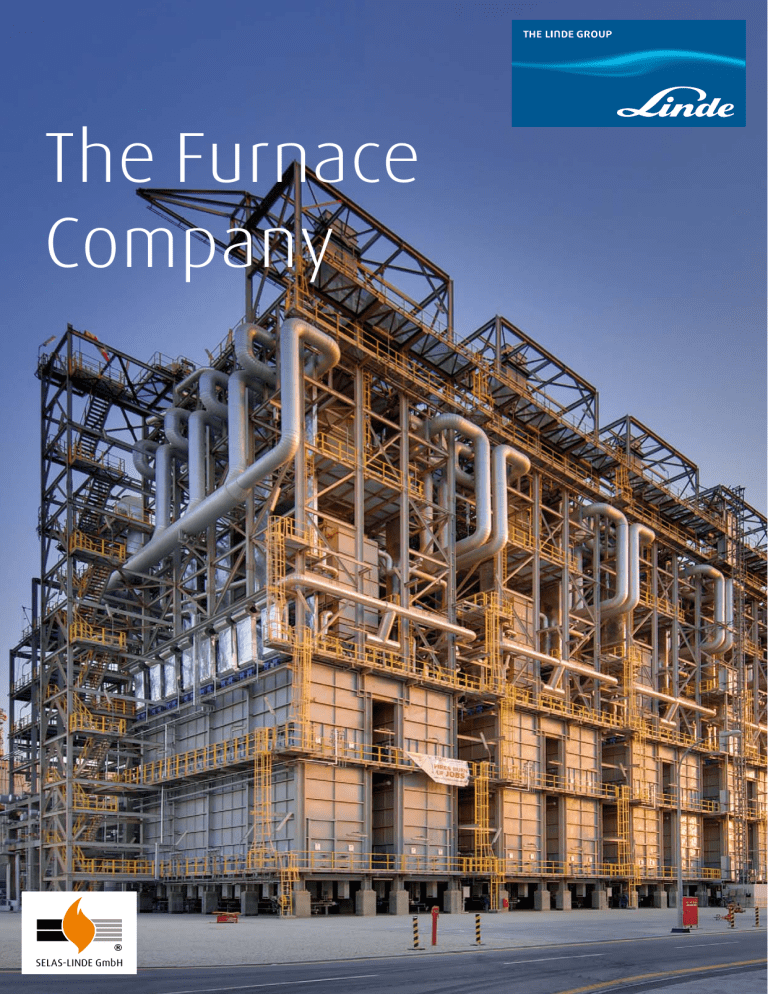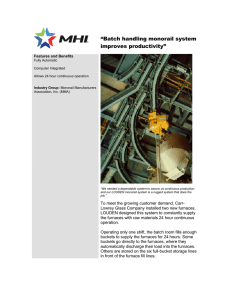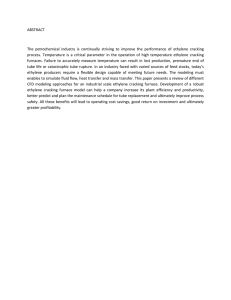
The Furnace Company SELAS-LINDE GmbH 2 Contents. 3 Introduction 4 SELAS-LINDE GmbH 5 Company history 6 Pyrolysis-furnaces for ethylene production 7 EDC-cracking furnaces 8 Steam reformer 9 Refinery heaters 10 Furnaces for direct-reduction plants 11 Other furnaces 12 Environmental technology 13 Thermal oxidation 14 Submerged combustion vaporiser system 15 The main advantages of the submerged combustion Sub-X® vaporiser system 16 Contact Sub-X® is a registered trademark of The Linde Group Cover photo: ethylene furnaces 3 Introduction. SELAS-LINDE GmbH – a wholly-owned subsidiary of The Linde Group, Engineering Division – is one of the world‘s leading suppliers of process plants in the fields of: Process furnaces for the chemical and petrochemical industry: – Pyrolysis furnaces for ethylene production – EDC cracking furnaces – Cracking furnaces for special chemicals, such as acetic acid and freon Reformer – Steam reformers for hydrogen and synthesis gas production Fired heater units for refineries: – Crude oil heaters – Vacuum oil heaters – Visbreaker – Platformer – HDS heaters – Reboilers – Superheaters Special-purpose furnace equipment: – Furnaces for iron direct reduction processes – Steam superheaters – Waste recovery units for gas turbines Environmental technology In addition to these fields, SELAS-LINDE is also a leader in the design and construction of plants for oxidizing gaseous and liquid wastes, including waste heat recovery, flue gas treatment, byproduct recovery for: – Halogenated hydrocarbons – PCBs – Pesticides – Dioxines – Pharmaceutical wastes – Aqueous salt laden wastes – Nitrogen-bound organics Vaporisation of cryogenic fluids Submerged combustion vaporiser system (Sub X®) for: – LNG – LPG – Nitrogen – Ethylene Range of Services SELAS-LINDE GmbH offers a wide range of services, tailored to customer specifications: – Studies – Project management – Basic and detail engineering – Procurement of services and materials – Construction, revamp and comissioning – Supervision of fabrication and construction – Start-up supervision – After-sales service – Project financing 4 SELAS-LINDE GmbH. SELAS-LINDE has extensive experience in the conceptual and detailed design and construction of turn-key plants, but also offers its customers all these services individually. The world-wide cooperation and exchange of information with Linde, the connection with the SELAS-LINDE Fired Heaters Division within Linde Impianti, Italia (LII), Rome and the sister company, Selas Fluid Processing Corporation (SFPC), Blue Bell, PA, USA, ensure state of the art technology and project execution. Efficient engineering work by experienced specialists and the use of the most modern 3D CAD systems (PDS) result in optimal design and reliable long-term operation of all SELAS-LINDE plants. Materials and equipment are procured world-wide in close cooperation with competent suppliers and business associates. After a contract has been completed, SELAS-LINDE remains a reliable partner for its customers, with its flexible and efficient after-sales service. SELAS-LINDE has decades of experience as a general contractor managing the complex logistics of plant procurement and construction. Proven project management and control systems guarantee strict adherence to cost, schedule and quality requirements. Proof of SELAS-LINDE‘s capability and know-how is the successful completion and commissioning of more than 2000 plants since the foundation of this company. Contracts are executed in compliance with all relevant international standards and rules, accompanied by continuous quality-assurance activities. SELAS-LINDE is certified under ISO 9001 since February 2000. Ethylene cracking furnace, Jilin Petrochemical Company, Jilin/China 5 Linde AG Engineering Division Munich, Germany Selas Fluid Processing Corp. and T-Thermal Division SELAS-LINDE GmbH and T-Thermal Division Bertrams Heatec AG Fired Heater Division within Linde Impianti (License of SL) Philadelphia, USA Munich, Germany Pratteln, Switzerland Rome, Italy SELAS LINDE GmbH T-Thermal Division within Linde Cryogenics Aldershot, UK Company history. SELAS-LINDE has a long tradition in furnace design, which dates back to the early thirties in the USA. The original company, Selas Corporation of America (in Pennsylvania), was involved in the technology of „fired process furnaces“ from an early date and developed this technology continuously. Starting in 1948, the company of Ernst Kirchner in Hamburg was developing its product line for „fired industrial furnaces“. After the death of the company‘s founder in 1970, the „fired industrial furnaces“ section was separated and sold to Selas Corporation of America. This acquisition was then renamed to Selas-Kirchner GmbH. In 1973, Selas Corporation of America and Linde AG, Process Engineering and Contracting Division signed a license agreement for the planning, manufacturing, and erection of pyrolysis furnaces for producing olefins. This also meant that the Selas, Kirchner, and Linde technologies in the field of „fired process-furnace plants for the chemical and refinery industries“ were combined. Over the following years, step by step Linde´s Process Engineering and Contracting Division acquired ever larger shares of Selas-Kirchner and of the „fired process-furnace plant“ division of Selas Corporation of America. In 1985, Linde AG became the sole owner of Selas-Kirchner, Germany, and of the „Process Furnaces“ division of Selas Corporation. This division now operates under the name Selas Fluid Processing Corporation (SFPC) in Blue Bell, USA. On January 1st, 1999, Selas-Kirchner GmbH was renamed to SELAS-LINDE GmbH. SELAS-LINDE GmbH and Selas Fluid Processing Corporation now market the entire know-how of the Selas, Kirchner and Linde furnace technologies exclusively throughout the world under the trademark „Selas“. Since its acquisition of T-Thermal in 1992, SELASLINDE possesses the extensive know-how and leading technology for thermal oxidation of gaseous and liquid wastes, in addition to its already available technology in the field of environmental engineering. Furthermore SELAS-LINDE designs, supplies and constructs plants for the vaporisation of cryogenic liquids. Today SELAS-LINDE is one of the leading global contractors in all above mentioned fields. 6 Pyrolysis-furnaces for ethylene production. In ethylene plants, the pyrolysis or ethylene cracking furnaces are the key elements for production of the basic chemicals ethylene, propylene, butadiene, etc. for the plastics industry. In designing such cracking furnaces based upon Linde´s PYROCRACK® technology, SELAS-LINDE can draw from its experience of more than 450 cracking furnaces built. Furnace group in Gofer, Germany Depending on available feedstocks and desired product distribution the appropriate PYROCRACK® cracking coil system will be chosen. The design features vertically arranged coils, for high product output, long furnace runtime and robust mechanical design. Firing is by a pure bottom-/sidewall, or combined sidewall and bottom burner arrangement. Integrated fluegas heat recovery allows furnace efficiencies of over 92 %. Ethylene cracking furnace, Elenac, Wesseling/Germany 7 EDC cracking furnace DOW-BSL, Schkopau EDC-cracking furnaces. Vinyl chloride (VCM) is one of the most important monomers for manufacturing a wide range of polymers today. The vinyl chloride monomer is produced by thermal cracking of ethylene dichloride (EDC) in a tubular furnace at temperatures of about 500°C and pressures of up to 30 bar. SELAS-LINDE has designed and built EDC cracking furnaces for the various processes, such as Goodrich, Stauffer, DOW, EVC, PPG, Hoechst, and Atochem throughout the world. The coils and the fire box are designed by means of a special computer model for the reaction kinetics. This allows the furnace design to be optimized with respect to the temperature/heat flux profile, residence time and pressure loss, taking both main and secondary reactions into account. The EDC furnaces are fired by natural-draft or forced-draft sidewall burners. The residual heat of the flue gases is utilized for generating steam or preheating the air, so that efficiencies of over 90 % can be achieved. EDC cracking furnace, fire box 8 Steam reformer. Many processes in the chemical industry are based on the use of hydrogen or synthesis gas. The most important industrial method of generating hydrogen and synthesis gas is steam reforming from hydrocarbons. This is carried out in top-fired primary reformers. The design of the waste-heat recovery system for the flue and process gases takes into account the customers‘s specific requirements, and allows furnace efficiencies of over 92 %. The SELAS-LINDE experience in designing and building reforming furnaces dates back to 1957. SELAS-LINDE has developed a special reaction model of the reforming process for designing reformers. This computer program enables the composition of the reformed gas to be calculated, and the firebox to be dimensioned for a wide range of feedstock. Steam reformer, Linde AG, Leuna/Germany Steam reformer, AGIP, Milazzo/Italy Refinery heaters. 9 All major processes in refineries require the heating and sometimes vaporisation of the hydrocarbons in direct fired heaters. SELAS-LINDE has more than sixty years of experience in designing and building refinery furnaces, and has constructed more than 450 furnaces around the world. Refinery heaters are designed according to the requirements of the process, for pressures ranging from 0.05 to 150 bar, and temperatures from 200°C to 900°C. The furnaces of SELASLINDE range in fired duties from 3 MW to more than 100 MW. The furnaces are single-cell and double-cell box and cylindrical types. They are fired by naturaldraft or forced-draft bottom or sidewall burners. Efficiencies of over 90 % are achieved by means of preheating of the air and/or hot oil, or by steam generation. Raffinery-heater, ERM, Mannheim/Germany 9 Furnaces for direct-reduction plants. The demand for sponge iron (DRI = direct reduced iron) as the feedstock for steel production in electric melting furnaces is growing. SELAS-LINDE supplies reducing-gas heaters tailored to the specific process for the newly developed methods of direct reduction (Finmet, Circored, Midrex plant using COREX gas, Danarex, Hylsamex). Circored DRI is made in a circulating and a stationary fluidized bed, using almost pure hydrogen. SELAS-LINDE supplied the three reducing-gas heaters for the first industrial-scale plant using this technology. Finmet DRI is made in four stationary fluidized-bed reactors, using a mixture of hydrogen and carbon monoxide. The reducing gas is heated from a minimum of 50°C to a maximum of 935°C. Reduction gas heater and reformer plant, Abu Dhabi/V.A.E. Midrex plant using COREX gas DRI is made in a conventional Midrex shaft, but using purified COREX gas as the reducing gas, which is a mixture of hydrogen and carbon monoxide. A tail gas from another part of the plant with an extremely low heat value, that would otherwise have to be flared off, can be used to preheat the reducing gas. This provides a considerable increase in the overall efficiency of the process. HYL/Danieli The DR iron will be produced in a reactor. The reduction gas consists of a mixture between H2 and CO and will be heated up to 930°C in a reduction process gas heater. For generating the reduction gas a syngas reformer including the waste heat recovery section will be used; the complete reformer and waste heat recovery unit will be also supplied by SELAS-LINDE. Reduction gas heater, Abu Dhabi/V.A.E. 11 Other furnaces. Steam superheater furnaces for styrene plants When dehydrogenating ethylbenzene to styrene, process steam is superheated to about 800°C in a furnace before being fed into the dehydrogenation reactor together with the ethylbenzene. The furnace is of double-cell construction with a common convection zone to utilize the waste heat. The tube system is gas fired from both sides by means of natural-draft or forced-draft floor burners. Gas-turbine waste-heat units This method combines gas-turbine operation with that of a conventional refinery furnace. This combination provides an alternative use for the exhaust from the gas turbine. Depending on process requirements, this type of plant can also be built with auxiliary firing equipment. The exhaust gases from a gas turbine are used in the horizontal waste-heat train to heat and partially vaporize crude oil in several tube bundles connected in series, and also to heat process water. Steam superheater, Hüls AG, Marl/Germany 12 Environmental technology. The SELAS-LINDE/T-Thermal environmental technology serves to dispose of almost all kinds of gaseous and liquid pollutants, particularly halogenated hydrocarbons and salt laden aqueous wastes. SELAS-LINDE/T-Thermal has many years of experience in designing and building incinerators for treating waste materials from the following industries: – Pharmaceutical industry – Chemical industry – Refineries – Pesticides industry – Plastics industry Typical plants consist of vertically or horizontally arranged combustion chambers with T-Thermal LV vortex burners and Sub-X quench systems, plus sections for heat recovery, fluegas treatment, or by-product recovery, depending on the application. SELAS-LINDE/T-Thermal can call on more than forty years experience in building more than 500 plants. Thermal oxidation unit for aqueous wastes, pharmaceutical industry/Portugal 13 Thermal oxidation. A pollution free environment SELAS-LINDE has commited as a company, to provide the equipment, service and technical support to resolve complex disposal problems. By tailor-made combustion technology, SELASLINDE can safely destroy nearly any kind of liquid and gaseous effluent encountered in industry. Since building our first thermal waste oxidation system in 1952, we have supplied over 500 installations world-wide to many of the leading process and manufacturing companies. In a technology where experience and expertise are critical, SELAS-LINDE is an acknowledged world leader. Guaranteed destruction efficiencies Thermal oxidation is the most direct, efficient, complete and final method for the disposal of especially hazardous liquid and gaseous industrial effluent. For some wastes it is the only practicable solution. Destruction efficiencies of SELAS-LINDE waste oxidation systems are guaranteed to meet European legislation or exceed the most demanding requirements anywhere in the world. We have successfully dealt with virtually every kind of hazardous and toxic waste. One example among many, a specially designed thermal system was selected for the US Army program to destroy the nation’s stockpile of obsolete chemical weapons, including nerve agents. A destruction efficiency of 99.999999 % was achieved. Test burns facility SELAS-LINDE can offer a test burn facility using a fully equipped and functional pilot test plant at our sister company’s site at SELAS FLUID Corporation, in Conshohocken, USA. The test enables SELAS-LINDE and their clients to pin down all the clean, complete chemical waste disposal through thermal oxidation variables of a proposed system and eliminates any potential problems. The documented test results are an essential big help in subsequent regulatory permitting. The test facility is one of the very few approved by the US EPA for hazardous waste testing. Thermal oxidation unit for organic and aqueous waste liquid, Böhlen/Germany 14 Submerged combustion vaporiser system. Since the invention, patent and installation of the first submerged combustion vaporiser system (Sub-X®) design unit by T-Thermal at Alabama Gas in 1965, and after acquisition of T-Thermal in 1992, SELAS-LINDE has continued to develop and supply a range of specialised units for heating and vaporisation of cryogenic fluids such as LNG, LPG, liquid nitrogen, oxygen ammonia and ethylene. The technology has been applied in LNG terminals world-wide, for both base-load and peak-shaving duties. SELAS-LINDE is the global market leader in the supply of submerged combustion vaporiser system. The Sub-X® vaporiser is an assembly of the following major components: – Vaporiser tank constructed in epoxy-coated carbon steel, stainless steel or concrete – Sub-X® burner complete with distribution duct and tubes – Process tube coil – Weir assembly – Combustion air fan, motor, inlet and outlet silencer and accustic housing as required – Control panel and instrumentation package for hazardous area classification – Optional cogeneration hot water distribution system LNG vaporisers, Belgium 15 LNG vaporiser for base-load plant/USA Main advantages of the submerged combustion Sub-X® vaporiser system. Operational safety The process tubes are submerged in a water bath and hence the tube wall temperature be maximum 55°C. No possible flame imingement with LNG contact. Fast response Rapid start-up and shut-down without process upset. It is possible, if required, to have the unit standing by on pilot only, prior to the introduction of the process fluid. High thermal efficiency With high heat flux and narrow temperature approach, high gross thermal effiencies, approaching 100 %, can be achieved. Heat transfer rate The bubble formation by direct contact heating and use of a patented weir arrangement provides a high level of turbulence and excellent recirculation over tubes containing the cryogenic fluid, thus maintaining temperature uniformity. Observations of units operations have indicated no ice build-up, even when operating with low bath temperatures. High operational reliability This can only be measured by the cumulative experience gained in the operation of these units. With the exception of facilities that have closed, all Sub-X LNG vaporisers installed since 1965 are still in operation. Environmental impact These units are designed to meet the new regulatory pressure with very low NOx emission values. SELAS-LINDE GmbH – Range of activities. Process furnaces for the chemical and petrochemical industry – Pyrolysis furnaces for ethylene production – EDC cracking furnaces – Cracking furnaces for special chemicals, such as acetic acid and freon Reformer – Steam reformers for hydrogen and synthesis gas production Fired heater units for refineries – Crude oil heaters – Vacuum oil heaters – Visbreaker – Platformer – HDS heaters – Reboilers – Superheaters Environmental Technology Plants for oxidizing gaseous and liquid wastes, including waste heat recovery, flue gas treatment, byproduct recovery for: – Halogenated hydrocarbons – PCBs – Pesticides – Dioxines – Pharmaceutical wastes – Aqueous salt laden wastes – Nitrogen-bound organics Vaporisation of cryogenic fluids Submerged combustion vaporiser system (Sub X®) for: – LNG – LPG – Nitrogen – Ethylene SL/1.1.e/09 Special-purpose furnace equipment – Furnaces for iron direct reduction processes – Steam superheaters – Waste recovery units for gas turbines Offices/Subsidiaries T-Thermal & Process Heater Technology c/o Linde CryoPlants Ltd. 1 Blackwater Park, Holder Road Aldershot, Hants GU12 4PQ Great Britain Phone: +44.1252.321-811 Fax: +44.1252.321-355 SELAS-LINDE Fired Heaters Divsion c/o Linde Impianti Italia S.p.A. Via Corona Boreale, 86 00054 Fiumicino, Roma Italy Phone: +39.06656.13-1 Fax: +39.06656.13-200 SELAS-LINDE GmbH Wolfratshauser Str. 138, 82049 Pullach, Germany Phone +49.89.7447.47-0, Fax +49.89.7447.47-17 E-Mail: selas-linde@linde-le.com, www.selas-linde.com Selas Fluid Processing Corporation T-Thermal Company/Thermatrix Five Sentry Parkway East, Suite 204 Blue Bell, Philadelphia 19422 United States of America Phone: +1.610.8340-300 Fax: +1.610.8340-473


